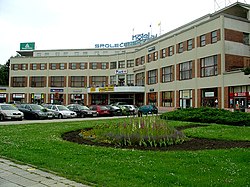Otrokovice
| Otrokovice | ||||
|---|---|---|---|---|
|
||||
| Basic data | ||||
| State : |
|
|||
| Historical part of the country : | Moravia | |||
| Region : | Zlínský kraj | |||
| District : | Zlín | |||
| Area : | 1961 ha | |||
| Geographic location : | 49 ° 13 ' N , 17 ° 32' E | |||
| Height: | 190 m nm | |||
| Residents : | 17,876 (Jan 1, 2019) | |||
| Postal code : | 765 02 | |||
| traffic | ||||
| Street: | Přerov - Napajedla | |||
| Railway connection: |
Přerov – Hodonín Otrokovice – Vizovice |
|||
| structure | ||||
| Status: | city | |||
| Districts: | 2 | |||
| administration | ||||
| Mayor : | Jaroslav Budek (as of 2014) | |||
| Address: | nám. 3. května 1340 765 02 Otrokovice |
|||
| Municipality number: | 585599 | |||
| Website : | www.otrokovice.cz | |||
Otrokovice (German Otrokowitz , older also Ottokowitz ) is an industrial city in the Czech Republic . It is located ten kilometers west of Zlín at the confluence of the Mojena and Dřevnice in the March and belongs to the Zlín district .
geography
The city is located northeast of the Mars Mountains or northwest of the Vizovice Mountains at the transition between Moravian Slovakia , Moravian Wallachia and Hanna . State road 55 runs through Otrokovice between Přerov and Napajedla , from which road 49 branches off to Zlín . The Štěrkoviště recreational area is located on the northern outskirts.
Neighboring towns are Skály, Tlumačov , Terezov and Machová in the north, Sazovice and Lhotka in the northeast, Tečovice and Malenovice in the east, Kvítkovice and Oldřichovice in the southeast, Pohořelice and Napajedla in the south, Žlutava and Bělov in the west and Kvasice in the northwest.
history
Otrokovice was first mentioned in writing in 1141 in a deed of ownership by the Olomouc bishop Heinrich Zdik . In the middle of the 14th century the place passed to secular owners and became part of the Malenovice estate. In 1570 a separate mansion was established in Otrokovice and four years later a fortress was built.
When Johann von Rottal acquired Otrokovice in 1649 and united it with the Napajedl lordship , the fortress was given up and converted into a castle around 1667. In 1767 the facility was converted into a storage facility. After the Rottalern came the Kobenzl, the Counts of Fünfkirchen and the Counts of Stockau. On July 18, 1841, the first train of the Kaiser-Ferdinand-Nordbahn ran between Lundenburg and Prerau past Otrokowitz; the place received a train stop in 1882.
In 1843 the place had 804 inhabitants and consisted of 132 houses. At that time there were 55 houses in Kvítkovice, in which 363 people lived. Agriculture was the livelihood in both villages. In 1845 a distillery was built on the Terezov farm. After the replacement of patrimonial Otrokowitz became an independent municipality in 1848.
After Aristides Baltazzi and his wife Marie, born Countess Stockau, established a stallion breeding facility in Napajedl in 1886 , their large estate in Otrokowitz was primarily used as pasture for the valuable animals.
In 1899 the Chapel of St. Anna was built. In the same year, the private local railway Otrokowitz – Zlin – Wisowitz was inaugurated, which in 1906 became state property. Due to regular flood damage, the rivers March and Dřevnice between Bělov , Otrokovice and Napajedla were regulated in 1906.
At the beginning of the 20th century, craftsmen increasingly settled in the former farming village. The good traffic situation at the junction of two frequented railway lines led to the settlement of industry. In 1930 the Zlín shoe manufacturer Tomáš Baťa bought the marshland between March and Dřevnice from Marie Baltazzi. Baťa let soil from the Tresny hill on the other side of the March in the Martian Mountains float onto the marsh floor and raised its level by one to four meters. The Baťov industrial area was laid out on the former marshland, in which branches of the Baťa company and the aircraft manufacturer Zlín were located. A settlement for the employees was built next to the industrial area according to the plans of the architects František Lydie Gahura and Vladimír Karfík . Tomáš Baťa did not live to see the completion, he died in Baťov in 1932 when his plane crashed. The center of the Baťov settlement was the community house built between 1933 and 1936 with the layout of a three-bladed propeller . By 1938 the population grew to around 8,000.
In 1960 Kvítkovice was incorporated and in 1964 Otrokovice received city rights. From 1966, the Barum tire plant was built, which began production in 1972 and is now known as Continental-Barum . This set in a renewed upswing of the city, whose population exceeded 20,000 by 1990. In the 1970s and 1980s, the town was redeveloped and new blocks were built as the city center in place of the old village of Otrokovice. All the old building fabric was lost.
After 1990 an architectural redesign of the uniform prefabricated buildings in the city center began. In 1995 the new St. Adalbert's Church was consecrated and in 1997 the Otrokovická Beseda Cultural Center.
Local division
The town of Otrokovice consists of the districts Kvítkovice ( Kwitkowitz ) and Otrokovice ( Otrokowitz ). The town of Bahňák, which used to be called Baťov , also belongs to the town .
Attractions
- former community center, now a hotel
- St. Adalbert Church, consecrated in 1995
- Monument to Tomáš Baťa in the park
Industry
The Barum tire factory , a subsidiary of Continental AG from Hanover , is the largest employer in Otrokovice.
Web links
Individual evidence
- ↑ Český statistický úřad - The population of the Czech municipalities as of January 1, 2019 (PDF; 7.4 MiB)
- ↑ http://mapy.mzk.cz/mzk03/000/903/964/2619267592/
- ^ Heinrich Baltazzi-Scharschmid, Hermann Swistun: The Baltazzi-Vetsera families in imperial Vienna. Böhlau, Vienna et al. 1980, ISBN 3-205-07160-3 ; Carl Hutschenreiter: My life for the thoroughbred. Schwingen-Verlag, Rosenheim et al. 1954; Václav Sova: Dějiny Napajedel a blízkého okolí. Karel Hylský, V Uherském Hradišti 1928.



